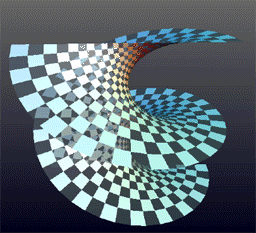Differential geometry theorem
This article has multiple issues. Please help improve it or discuss these issues on the talk page. (Learn how and when to remove these messages)
|

Gauss's Theorema Egregium (Latin for "Remarkable Theorem") is a major result of differential geometry, proved by Carl Friedrich Gauss in 1827, that concerns the curvature of surfaces. The theorem says that Gaussian curvature can be determined entirely by measuring angles, distances and their rates on a surface, without reference to the particular manner in which the surface is embedded in the ambient 3-dimensional Euclidean space. In other words, the Gaussian curvature of a surface does not change if one bends the surface without stretching it. Thus the Gaussian curvature is an intrinsic invariant of a surface.
Gauss presented the theorem in this manner (translated from Latin):
- Thus the formula of the preceding article leads itself to the remarkable Theorem. If a curved surface is developed upon any other surface whatever, the measure of curvature in each point remains unchanged.

The theorem is "remarkable" because the definition of Gaussian curvature makes ample reference to the specific way the surface is embedded in 3-dimensional space, and it is quite surprising that the result does not depend on its embedding.
In modern mathematical terminology, the theorem may be stated as follows:
The Gaussian curvature of a surface is invariant under local isometry.
Elementary applications

A sphere of radius R has constant Gaussian curvature which is equal to 1/R. At the same time, a plane has zero Gaussian curvature. As a corollary of Theorema Egregium, a piece of paper cannot be bent onto a sphere without crumpling. Conversely, the surface of a sphere cannot be unfolded onto a flat plane without distorting the distances. If one were to step on an empty egg shell, its edges have to split in expansion before being flattened. Mathematically, a sphere and a plane are not isometric, even locally. This fact is significant for cartography: it implies that no planar (flat) map of Earth can be perfect, even for a portion of the Earth's surface. Thus every cartographic projection necessarily distorts at least some distances.
The catenoid and the helicoid are two very different-looking surfaces. Nevertheless, each of them can be continuously bent into the other: they are locally isometric. It follows from Theorema Egregium that under this bending the Gaussian curvature at any two corresponding points of the catenoid and helicoid is always the same. Thus isometry is simply bending and twisting of a surface without internal crumpling or tearing, in other words without extra tension, compression, or shear.
An application of the theorem is seen when a flat object is somewhat folded or bent along a line, creating rigidity in the perpendicular direction. This is of practical use in construction, as well as in a common pizza-eating strategy: A flat slice of pizza can be seen as a surface with constant Gaussian curvature 0. Gently bending a slice must then roughly maintain this curvature (assuming the bend is roughly a local isometry). If one bends a slice horizontally along a radius, non-zero principal curvatures are created along the bend, dictating that the other principal curvature at these points must be zero. This creates rigidity in the direction perpendicular to the fold, an attribute desirable for eating pizza, as it holds its shape long enough to be consumed without a mess. This same principle is used for strengthening in corrugated materials, most familiarly with corrugated fiberboard and corrugated galvanised iron, and in some forms of potato chips as well.
See also
- Second fundamental form
- Gaussian curvature
- Differential geometry of surfaces
- Carl Friedrich Gauss#Theorema Egregium
Notes
- Geodetical applications were one of the primary motivations for Gauss's "investigations of the curved surfaces".
- wired.com
References
- Gauss, C. F. (2005). Pesic, Peter (ed.). General Investigations of Curved Surfaces (Paperback ed.). Dover Publications. ISBN 0-486-44645-X.
- O'Neill, Barrett (1966). Elementary Differential Geometry. New York: Academic Press. pp. 271–275.
- Stoker, J. J. (1969). "The Partial Differential Equations of Surface Theory". Differential Geometry. New York: Wiley. pp. 133–150. ISBN 0-471-82825-4.
External links
- Theorema Egregium on Mathworld
- Dominic Vella : Some wrinkles in Gauss' Theoreme : Mathematics of everday objects from Pizza to Umbrellas and Parachutes (G. I. Taylor Lecture) on YouTube, 30 January 2023